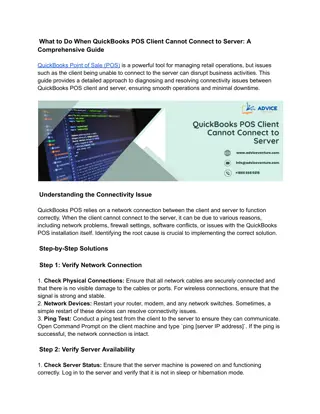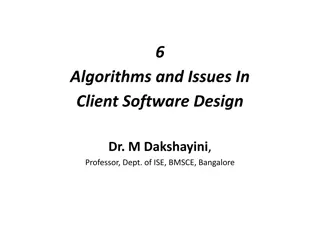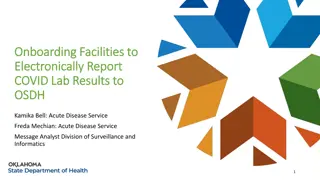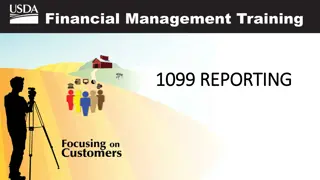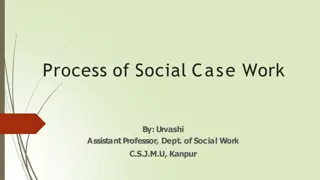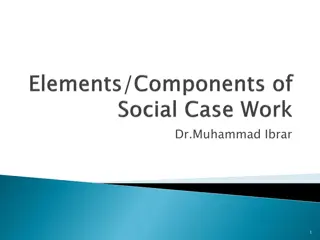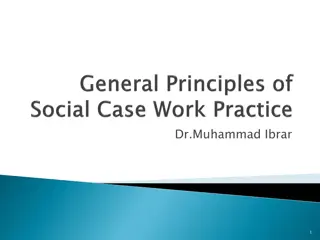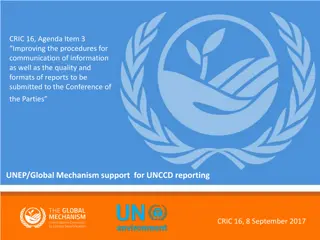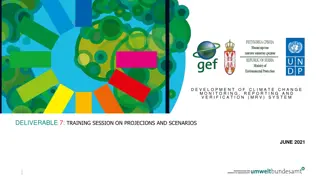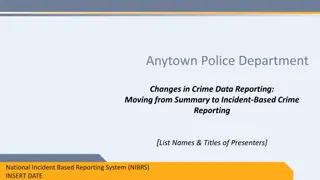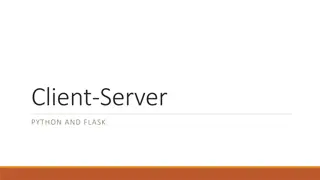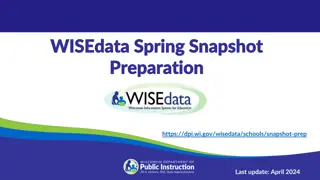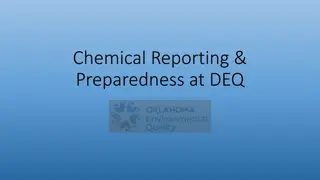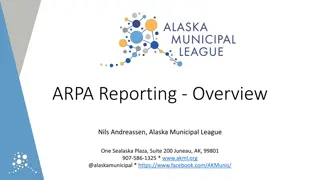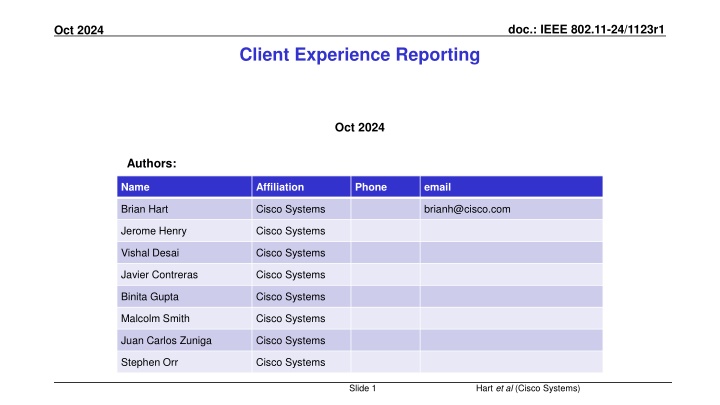
Client Experience Reporting in IEEE 802.11-24/1123r1
Explore the client experience reporting in the IEEE 802.11-24/1123r1 standard, focusing on infrastructure visibility, wireless coverage, channel utilization, throughput efficiency, and client metrics. Learn about critical factors affecting client experience and the measures taken to enhance it.
Download Presentation

Please find below an Image/Link to download the presentation.
The content on the website is provided AS IS for your information and personal use only. It may not be sold, licensed, or shared on other websites without obtaining consent from the author. If you encounter any issues during the download, it is possible that the publisher has removed the file from their server.
You are allowed to download the files provided on this website for personal or commercial use, subject to the condition that they are used lawfully. All files are the property of their respective owners.
The content on the website is provided AS IS for your information and personal use only. It may not be sold, licensed, or shared on other websites without obtaining consent from the author.
E N D
Presentation Transcript
doc.: IEEE 802.11-24/1123r1 Oct 2024 Client Experience Reporting Oct 2024 Authors: Name Affiliation Phone email Brian Hart Cisco Systems brianh@cisco.com Jerome Henry Cisco Systems Vishal Desai Cisco Systems Javier Contreras Cisco Systems Binita Gupta Cisco Systems Malcolm Smith Cisco Systems Juan Carlos Zuniga Cisco Systems Stephen Orr Cisco Systems Slide 1 Hart et al (Cisco Systems)
doc.: IEEE 802.11-24/1123r1 Oct 2024 The infrastructure seeks an excellent client experience, but doesn t always have adequate visibility Brief onboarding time When did the client s onboarding effort first start? Comprehensive wireless coverage throughout the deployment But a client that cannot be heard does not register Channel utilization not too high Interference at client interference at AP Low proportion of retries wrt tries Collided client transmissions are not received; cannot be counted High MCSs / NSSs / data rate with individual clients High system throughput / efficiency Especially for QoS TIDs, transmit buffers are shallow almost always AP could use fast BSR polling but cost is too high SLAs expressed by SCS(QC) met (with margin) AP might not receive SST; does not see expired traffic (ditto R-TWT: was the underlying SLA met?) Brief outages during roaming AP does not know when a client s upper layer UL traffic reached its MAC-SAP Slide 2 Hart et al (Cisco Systems)
doc.: IEEE 802.11-24/1123r1 Oct 2024 Even so, the infrastructure applies its best experience and augments it with client-provided metrics where available APs have many control knobs that affect the client experience AP locations, RRM (AP power, channel and channel width), AP scheduler, (MU)EDCA parameters see backup APs do have many measures for an excellent client experience Throughput, DL latency histogram for QoS traffic, channel utilization at AP, 11k client reports such as Beacon Report But, from the previous slide, these measures are inevitably incomplete: even with all the specific 11k- defined metrics, the AP doesn t capture the client s full perspective of its experience 1: Critical Reason Codes 2: Important + known + readily quantifiable 11k 3: Impactful but not readily quantifiable or not previously known this presentation Impact 1 3 2 3 3 3 Issue# Slide 3 Hart et al (Cisco Systems)
doc.: IEEE 802.11-24/1123r1 Oct 2024 Overarching Concept Enable clients to be able to report their recent Client Experience Score (CES) to the network Consumed manually: Client experience score drops broadly after roll-out of new infrastructure SW release pull the release and root cause Client experience score is low (or drops) for a few client SKUs contact vendor and clarify their concern Other issues e.g., add more APs / move APs / upgrade APs / implement feature X / enable feature Y Consumed automatically: Expectation is for a future with more automated network management (AI/ML; e.g., AI RRM) Network correlates scores against events; performs ongoing trialing of alternatives (using its control knobs) to discover how to maximize the CES Tweak RRM behavior / tweak scheduler behavior AI/ML carries risks: e.g., RL can overfit; always desirable to have CES for a reality-check in the training + validation + test data-sets Network performs correlation with environmental & network events; seeks more of them Infrastructure puts more weight on Client Experience Client puts more effort into Client Experience Client Experience score goes up Client Experience score goes down Network performs correlation with environmental & network events; seeks less of them The client must calculate their Client Experience Score such that the client would be happier with a network that it describes by a higher score than by a lower score The infrastructure must incorporate this feedback and make increased client satisfaction an explicit component of its overall goal then, what the client puts in strongly affects how much consideration the infrastructure gives it, and so what the client gets out (virtuous circle to spur more effort) Slide 4 Hart et al (Cisco Systems)
doc.: IEEE 802.11-24/1123r1 Oct 2024 Option A: One Client Experience Score, plus areas for improvement Client can report a Client Experience Score ( Health Score ): e.g., 1 (all but unusable) to 255 (faultless) To accommodate the range of clients and how much effort they can allocate to determining a Client Experience Score, exactly how a client populates the value may be implementation dependent But there should be a quantified Effort score: e.g., 1 (no effort) to 5 (max effort) The overarching requirement is for the client to pick a way to calculate their Client Experience Score such that the client would be happier with a network that it describes by a higher score than by a lower score Client can also report area(s) for improvement by the network: E.g., 802.11 coverage/throughput, 802.11 latency/jitter, scanning and roaming, reliability, power efficiency, in- device coexistence, security/upper layers, backhaul, The union of areas defined should provide complete coverage of the network characteristics; and each area should be specific enough that the network can reasonably identify / correlate what kind of actions would mitigate the concern Slide 5 Hart et al (Cisco Systems)
doc.: IEEE 802.11-24/1123r1 Oct 2024 Option B: Multiple Client Experience Scores, one per topic (+Effort) Example Client Experience Scores Example circumstances where client reports a worse metric Example circumstances where client reports a better metric 802.11 Coverage / Throughput Strong DL RSSI at strongest AP; high MCSs; TX buffers are mostly empty; and/or the client is operating at max PHY speed with high channel access duty cycle; no/minimal packet loss Weak DL RSSI at strongest AP; low MCSs; traffic arrival rate from client s upper layers is higher than the Wi-Fi transmission rate; the client s TX buffers are overflowing; many retries; long contention time; MSDU expiry reached (aka packet loss) 802.11 Latency/Jitter VO/VI packet loss; high VO/VI buffer depth (and/or MSDUs are dwelling a long time there) and/or VO/VI buffers are overflowing (any buffers, if mis- marked traffic?); codec in upper layers has downshifted to (much) lower than the highest quality; SCS(QC) SLA not met; bad ping time No/minimal VO/VI packet loss, low VO/VI buffer depth (and/or MSDUs are spending little time dwelling there; VO/VI buffers (almost) never overflow; codec in upper layers is operating at its highest quality Scanning and Roaming Roaming often; panic roams required; roaming recommendations (e.g., in Neighbor Report or ?BTM) not good, long dead times; often serving AP s RSSI is low; (often) not seeing two APs with RSSIs > -67 dBm Serving AP s RSSI is high so roaming not a consideration; or roaming occurs with minimal scanning and little downtime especially when QoS flows are active; no panic roams; client always sees two APs at > -67 dBm Reliability Periods of no frame transmission or no association;, missing multiple beacons in a row; multiple MSDUs in a row being expired out; received MPDUs being released to upper layers despite SN holes Continuous connectivity with no extended dropouts Power efficiency On battery and low MCS on TX/RX; long periods of idle RX or backoff; many retries Wall powered or transmit/active receive at high MCS; with few retries In-Device Coexistence Taking a long time to change PM bit, data rates drop markedly after each IDC absence, heightened retries, etc Client leaves and returns with minimal Wi-Fi downtime Security/upper layers Full connectivity Auth failure; EAP failure; no IP address; can t reach gateway; DNS not working; stuck at captive portal; no Internet connectivity to the usual places Backhaul IP/TCP/peer throughput much lower than wireless throughput IP/TCP/peer throughput similar to wireless throughput Slide 6 Hart et al (Cisco Systems)
doc.: IEEE 802.11-24/1123r1 Oct 2024 Protocol Details Measurement Request of type Client Experience(mode=reset+start, periodicParams, conditonalParams) To calibrate/compare the information over time as the client mix evolves, it is preferred that: The Client Experience Score(s) (CES(s)) be subject to quantitative guidelines (FFS), and/or The sender identifies itself via one or more of: device type/make/model/SW versions/chipset ID [via 11v] Protocol expectations: AP sends Measurement Request indicating: 1. Reset any pre-existing CES-related state and begin calculating CES(s), to be reported: 1. At a defined single-shot or periodic schedule (e.g., once per xx minutes) and/or 2. At a defined trigger condition (e.g., CES(s) have markedly increased or decreased) 2. Or a request for the latest (cumulating) CES(s) 3. Or a request to stop calculating CES(s) (e.g., a request with no periodic reporting or trigger conditions) Upon request (2) or periodically (1.1) or after the triggering condition (1.2), the client sends a Measurement Report containing the Client Experience score(s) Item 1 helps the Client Experience Score(s) to be compared before-and-after a network behavioral change Measurement Report(Accept) period elapses Measurement Report of type Client Experience Client Experience drops by 10% Measurement Report of type Client Experience Measurement Request of type Client Experience(mode=updateRequest) Measurement Report of type Client Experience Measurement Request of type Client Experience(mode=stop) Slide 7 Hart et al (Cisco Systems)
doc.: IEEE 802.11-24/1123r1 Oct 2024 Summary Benefit of Client Experience: Enable clients to be able to report their recent Client Experience ( health ) to the network such that the system of APs (+compute) and clients has the information needed to improve the collective client experience of the system Ongoing trialing of alternatives can occur, to discover how to maximize the client experience This provides clients with a seat at the table when decisions are being made on their behalf The goal of this process is for clients to collectively see a higher Client Experience score The proposal is very flexible for clients: What the client puts in is what the client gets out Slide 8 Hart et al (Cisco Systems)
doc.: IEEE 802.11-24/1123r1 Oct 2024 References [1] 24/0518, Troubleshooting Metric Follow Up , Jerome Henry et al, Cisco Systems Slide 9 Hart et al (Cisco Systems)
doc.: IEEE 802.11-24/1123r1 Oct 2024 Strawpoll 1 If Client Experience Score were to be added to the SFD, do you most prefer: Option A (1 Client Experience Score + list of areas for improvement) Option B (Multiple Client Experience Scores, one per area) Abstain Slide 10 Hart et al (Cisco Systems)
doc.: IEEE 802.11-24/1123r1 Oct 2024 Strawpoll 2 Do you agree to add the following text to the 11bn SFD: The 802.11bn amendment will define an exchange that allows non-AP STAs to rate their Client Experience of the current network Y / N / A Slide 11 Hart et al (Cisco Systems)
doc.: IEEE 802.11-24/1123r1 Oct 2024 Backup Slide 12 Hart et al (Cisco Systems)
doc.: IEEE 802.11-24/1123r1 Oct 2024 AP has many control knobs, at different time scales, that affect the client experience Very Short Very long Long Short How often to trigger each client (&/or solicit BSR) How DL traffic is scheduled to clients How often to sound each client MCS/NSS/RU selection for DL and for UL Use of OFDMA / MU-MIMO / SU (and level of padding) AP positions (dense, sparse, coverage holes) Major feature support (11n/ ac/ ax/ be/.., 11r, ) Backhaul throughput / latency to intranet Backhaul throughput / latency to Internet Number of SSIDs Choice and change frequency of Primary channel / Channel width Choice and change frequency of AP TX power / Local TPC/TPE Coverage overlap between adjacent APs EDCA and MU EDCA parameters Medium feature support and enablement (FILS, TWT, R- TWT, P2P TWT) BSS Coloring Network contribution to time to associate Network contribution to time to roam BA/TWT/SCS/ agreements accepted / countered / rejected Use of BSS-wide mgmt. features like AP Add/Delete, Advertised TTLM as APs juggle tasks Use of per-STA mgmt. features like BTM to another AP, BTM+TTLM, BTM+Link Add+Delete to steer clients to clearer air Use of legacy features like Probe Response suppression, Association Rejection, ML Setup with fewer links offered, etc Slide 13 Hart et al (Cisco Systems)


